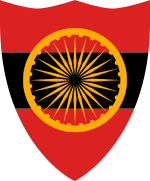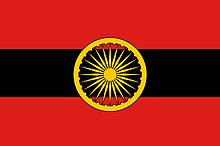
A | B | C | D | E | F | G | H | CH | I | J | K | L | M | N | O | P | Q | R | S | T | U | V | W | X | Y | Z | 0 | 1 | 2 | 3 | 4 | 5 | 6 | 7 | 8 | 9
| Western Command | |
|---|---|
 Western Command's insignia today | |
| Active | 1904 - 1908 1920 - 1938 1948 - Present |
| Country | |
| Branch | |
| Type | Command |
| Garrison/HQ | Chandimandir, Haryana |
| Motto(s) | सर्वदा विजयी भव (May you always win) |
| Commanders | |
| Current commander | Lt Gen Manoj Kumar Katiyar |
| Notable commanders | FM K. M. Cariappa Gen S M Shrinagesh Gen K. S. Thimayya Gen P. N. Thapar FM Sam Manekshaw Lt Gen Harbaksh Singh Lt Gen K. P. Candeth Gen T. N. Raina Gen K. V. Krishna Rao Gen Krishnaswamy Sundarji Gen S. F. Rodrigues Gen B. C. Joshi Gen J. J. Singh |

Western Command is a Command-level formation of the Indian Army. It was formed in 1920. It was disbanded following its demotion to an independent district and eventual merge with Northern Command to form the North-western Army. It was re-raised in 1947 following the transfer of Northern Command HQ to Pakistan. Until 1972, it was responsible for India's border with Pakistan in the North and West and the Chinese border in the North. The Command HQ is located at Chandimandir, Haryana, about 5 km east of Chandigarh.
Lieutenant General Manoj Kumar Katiyar is the GOC-in-C: he took over on 1 July 2023.[1][2]
History
Pre-Independence
The Presidency armies were abolished with effect from 1 April 1895 when the three Presidency armies of Bengal, Bombay, and Madras became the Indian Army.[3] The Indian Army was divided into four Commands: Bengal Command, Bombay Command, Madras Command and Punjab Command, each under a lieutenant general.[3]
Between 1904 and 1908, the Bombay Command was renamed as the Western Command. In 1908, the four commands were merged into two Armies: Northern Army and Southern Army as recommended by then Commander-in-Chief, Indian Army Lord Kitchener. This system persisted until 1920 when the arrangement reverted to four commands again: Eastern Command, Northern Command, Southern Command and Western Command.[4]
In 1937, Western Command was downgraded to become the Western Independent District commanded by a major general. In April 1942, the Western Independent District was absorbed in the Northern Command which itself was re-designated as North Western Army.[5]
Re-raising
After the partition of India, the erstwhile command HQ, Northern Command, went to Pakistan and was renamed as GHQ, Pakistan. The communal violence of partition necessitated the raising of a new command headquarters to relieve Army Headquarters of the day to day overseeing of operations of the two independent areas in north India.[6]
This command, initially named Delhi and East Punjab Command was raised in Delhi on 14 September 1947 with Lt Gen Sir Dudley Russell as its commander. It was responsible to administer the Delhi Independent Area and the East Punjab Independent Area.[6]
On 26 October 1947, following the accession of Jammu and Kashmir to India, Western Command was put in charge of all Indian Army operations to secure the area for India.[6]
Initially a division sized force Jammu and Kashmir Division was raised on 5 November 1947 under Maj Gen Kulwant Singh for overseeing operations in Jammu and Kashmir.[6] This was later split into two parts Jammu Division (under Maj Gen Atma Singh) and Srinagar Division (under Maj Gen K.S. Thimayya) to oversee operations in Jammu and Kashmir respectively.[7]
The II Corps (Ambala), IX Corps (Yol), XI Corps (Jalandhar) and 40th Artillery Division (Ambala[8]) are control operational units in Western Command.[9]
Structure
Command's Area Of Responsibility (AOR) covers the states of Punjab, Haryana, Delhi and parts of Jammu.[10]
The Western Command has been assigned operational units:- II Corps, IX Corps, XI Corps and 40th Artillery Division. The command in total has following units under its belt :- 6 infantry divisions, 1 armoured division, 1 artillery division, 1 Reorganised Army Plains Infantry Division (RAPID), 3 armoured brigades, 1 mechanized brigade, 1 Air-defence brigade, and 1 engineering brigade.
| Structure of Western Command | ||||
|---|---|---|---|---|
| Corps | Corps HQ | GOC of Corps
(Corps Commander) |
Assigned Units | Unit HQ |
| II Corps
(Kharga Corps) |
Ambala, Haryana | Lt Gen Rahul R Singh | 1 Armoured Division | Patiala, Punjab |
| 9 Infantry Division | Meerut, Uttar Pradesh | |||
| 22 Infantry Division | Meerut, Uttar Pradesh | |||
| 40 Artillery Division | Ambala, Haryana | |||
| 16 (Independent) Armoured Brigade | Mamun, Punjab | |||
| 612 Air-defence Brigade | N/A | |||
| 474 Engineering Brigade | N/A | |||
| IX Corps
(Rising Star Corps) |
Yol, Himachal Pradesh | Lt Gen SP Singh | 26 Infantry Division | Jammu, Jammu & Kashmir |
| 29 Infantry Division | Pathankot, Punjab | |||
| 2 Armoured Brigade | Mamun, Punjab | |||
| 3 Armoured Brigade | Ratnuchak, Jammu & Kashmir | |||
| XI Corps
(Vajra Corps) |
Jalandhar, Punjab | Lt Gen Vijay B Nair | 7 Infantry Division | Firozpur, Punjab |
| 15 Infantry Division | Amritsar, Punjab | |||
| 23 (Independent) Armoured Brigade | Khasa, Punjab | |||
| 55 (Independent) Mechanised Brigade | Beas, Punjab | |||
Precursors (1855–1947)
Following is the list of precursors to the Western Command and their commanders:[11]
Bombay Army (1855–1895)
Bombay Command (1895–1904)
| General Officer Commanding-in-Chief Bombay Command | ||||
|---|---|---|---|---|
| Rank | Name | Appointment date | Left office | Unit of commission |
| Lieutenant General | Sir Charles E. Nairne | April 1895 | October 1898 | Bengal Artillery |
| General | Sir Robert C. Low | October 1898 | October 1903 | Bengal Army |
| Lieutenant General | Sir Archibald Hunter | October 1903 | October 1904 | 4th (King's Own Royal) Regiment |
Western Command (1904–1908)
| General Officer Commanding Western Command | ||||
|---|---|---|---|---|
| Rank | Name | Appointment date | Left office | Unit of commission |
| Lieutenant General | Sir Archibald Hunter | Oct 1904 | Jun 1907 | 4th (King's Own Royal) Regiment |
Western Command (1920–1938)
| General Officer Commanding Western Command | ||||
|---|---|---|---|---|
| Rank | Name | Appointment date | Left office | Unit of commission |
| Lieutenant General | Sir Walter P. Braithwaite | Dec 1920 | Jun 1923 | Somerset Light Infantry |
| Lieutenant General | Sir George M. Kirkpatrick | Jun 1923 | Jun 1927 | Royal Engineers |
| Lieutenant General | Sir Charles H. Harington | Jun 1927 | Jun 1931 | King's Regiment (Liverpool) |
| Lieutenant General | Sir Torquil G. Matheson | Jun 1931 | Jun 1935 | Bedfordshire and Hertfordshire Regiment |
| Lieutenant General | Sir Ivo L. B. Vesey | Jun 1935 | Mar 1936 | Queen's Royal Regiment (West Surrey) |
| Lieutenant General | Sir Walter W. Pitt-Taylor | Mar 1936 | Nov 1938 | Rifle Brigade (The Prince Consort's Own) |
Western Independent District (1938–1942)
| General Officer Commanding Western Independent District | ||||
|---|---|---|---|---|
| Rank | Name | Appointment date | Left office | Unit of commission |
| Major General | Thomas J. Hutton | Aug 1938 | July 1940 | Royal Artillery |
| Major General | John F. Evetts | July 1940 | Feb 1941 | Cameronians (Scottish Rifles) |
| Lieutenant General | Edward F. Norton | Feb 1941 | Apr 1942 | Royal Artillery |
North-Western Army (1942–1945)
| General Officer Commanding-in-Chief North-Western Army | ||||
|---|---|---|---|---|
| Rank | Name | Appointment date | Left office | Unit of commission |
| General | Sir Cyril D. Noyes | Apr 1942 | May 1943 | Royal Scots Fusiliers |
| General | Sir Edward P. Quinan | May 1943 | Aug 1943 | Worcestershire Regiment |
| General | Sir Henry Finnis | Aug 1943 | May 1945 | Indian Staff Corps |
| Major-General | Cecil Toovey
(acting) |
Jun 1945 | Oct 1945 | Indian Staff Corps |
| General | Sir Richard N. O'Connor | Oct 1945 | Nov 1945 | Cameronians (Scottish Rifles) |
Delhi and East Punjab Command (1947–1948)
| General Officer Commanding-in-Chief Delhi and East Punjab Command | ||||
|---|---|---|---|---|
| Rank | Name | Appointment date | Left office | Unit of commission |
| Lieutenant General | Dudley Russell | 15 August 1947 | 19 January 1948 | 97th Deccan Infantry |
